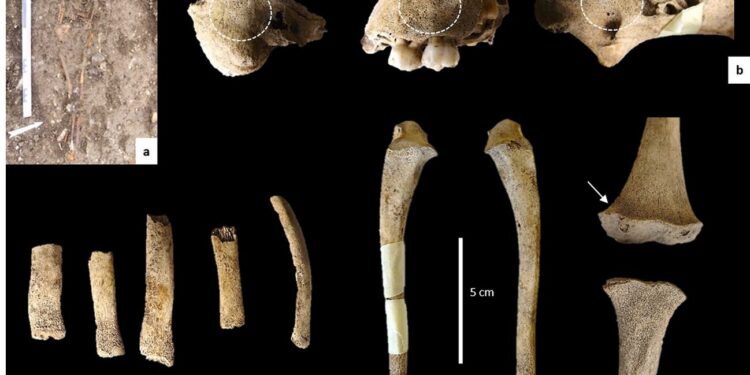a) In situ burial of individual SP5; (b) pathological signs associated with a possible scurvy; (c) the pathological signs associated with a possible scurvy and rachism; (d) pathological signs associated with rays. Credit: Zinn et al. 2025
A recent study, published in the International Paléopathology Journalexamined the skeletal remains of a child who lived in the middle of the 19th century in France. The study revealed that the child had suffered from Ricotte and Scorbut and was probably treated using mercury before his death at only 3 to 4 years.
Mercury is a highly toxic metal that has been used to treat various diseases for centuries, including venereal and skin diseases, say researchers Alexandra Zinn and Dr Antony Colombo, “there is a real paradox between the high toxicity of Mercury (which we know today) and its historical attraction. In the past, Mercury has been considered magical and esoteric.
“More than 2,000 years ago, Mercury was already used in Greek, Arabic, Chinese and Egyptian medicine, in particular for the treatment of skin and venereal diseases.
The use of Mercury continued during the industrial revolution, which began in the United Kingdom in the 18th century and spread to other countries in the 19th century.
It has been characterized by rapid technological and scientific growth, which has led to the invention and advancement of many public health and public health systems. In some cases, this has led to an improved quality of life, at higher birth rates, at lower infant mortality rates, longer life expectations and reduced mortality rates from infectious diseases.
However, industrialization has also led to an increase in air pollution, overcrowding in urban areas and high children’s work rates in factories and mines, which has led to the prevalence of other diseases.
Scorbut and rushy, two diseases characterized by severe deficiencies in vitamin C and D, respectively, were widespread, in particular in the lower and medium socio-economic classes.
“We know that industrialization had a negative impact on the living conditions of children and health, with an increase in deficiency diseases such as richitism in the United Kingdom. But industrialization in France was born in a slightly different way for England: later and less suddenly, against a context of intense political and social changes,” said Zinn and Colombo.
“Bioanthropologists in France have done relatively little research on this period. It is during a previous project, published by A. Colombo and other colleagues in 2021, to understand these health conditions in France, using a paleo-epidemiological approach to ricotoirs during this transition period, based on anthropological data and historical archives, that they identified Mercury as a common treatment.
“So we wanted to know if it was possible to detect mercury in skeletal mineral structures and if it could be interpreted as a treatment for the ricoteuse.”
The skeletal remains used in the study were recovered from the archaeological site of rue Thubeuf, located in Rouen, in France. The excavations of the cemetery of the parish of Saint-Gervais revealed 53 burials dating from the 18th and 19th centuries. Among these remains, 18 have been studied, including the individual SP5.
With the implementation of physical analysis, micro-TC scanning, fluorescence of X-rays and atomic absorption spectrometry with cold steam (a method of sensitive chemical detection), the researchers were able to determine that the child had suffered both from rushitism and scorbut and had abnormally high levels of mercury in his bones and teeth.
The origin of the mercury in the child’s bones should be determined to deduce if the mercury had been administered as a medical or by-product treatment of environmental contamination.
The contamination of the buried soil was quickly excluded because the geology of Rouen does not contain minerals or materials rich in mercury. In addition, contamination of the occupation has been excluded. Rouen was known for his Cotton textile production, a profession that has not implemented Mercury.
While Earthwork Productions used mercury for gilding and enamel processes, they took place outside of Saint-Gervais, which makes it an improbable source of mercury. The only contenders for professional contaminants were mirror and hat factories, which existed in the outskirts of the archaeological site.
However, given the young age of the child, it would have been unlikely that it would have been in these factories or exposed to them to the same extent as the adults who work.
The researchers considered the possibility of contamination by mercury of food, in particular by the consumption of certain types of fish. However, the mercury contamination of fish stocks was born with industrialization and large -scale mercury emissions at the end of the 20th century.
It was therefore very likely that the mercury found in the child’s bones and teeth is the result of a medical administration.
“Mercury treatments were painful and exhausting, which led patients to feel undesirable effects, in particular asphyxiation, dizziness, delirium, loss of teeth and Mercurial glossitis ” (inflammation of the language due to exposure to mercury). Usually, treatment was considered to be complete when excessive salivation appeared).
Based on the concentrations of mercury in the teeth and bones, it was determined that the child had probably been administered the fatal metallic substance in the last months of his life, leading to severe mercury poisoning.
More information:
Alexandra Zinn et al, archaeometric detection of mercury: a study of paleopharmacological cases of the skeletal remains of a child suffering from vitamins (Rouen, France, end of the 18th century of the 18th century), International Paléopathology Journal (2025). DOI: 10.1016 / J.IJPP.2025.02.006
© 2025 Science X Network
Quote: The study discovers mercury treatment in the French child of the 19th century suffering from Ricotte and Scorbut (2025, April 2) recovered on April 2, 2025 from
This document is subject to copyright. In addition to any fair program for private or research purposes, no part can be reproduced without written authorization. The content is provided only for information purposes.



